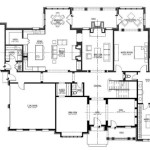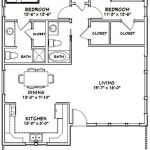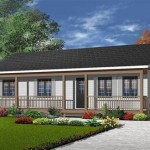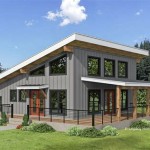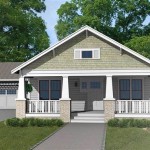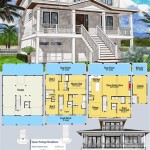Understanding 1,000 Square Foot House Plans
The allure of a 1,000 square foot house plan lies in its efficient use of space, affordability, and environmental friendliness. These plans are gaining popularity, particularly among first-time homebuyers, minimalist enthusiasts, and those seeking to downsize. A 1,000 square foot house, while compact, can be designed to accommodate a wide range of lifestyles and needs with careful planning and prioritization of design elements.
When considering a house of this size, it's crucial to understand the trade-offs involved. While cost savings are significant, living space is limited, demanding thoughtful storage solutions and multi-functional areas. Successful 1,000 square foot house plans prioritize open floor plans, strategic window placement, and clever built-in features. A comprehensive understanding of these elements is essential for maximizing the potential of a smaller living space.
Key Considerations for 1,000 Square Foot House Plans
Several factors must be carefully considered when selecting or designing a 1,000 square foot house plan. These considerations impact not only the aesthetic appeal of the house but also its functionality and overall livability. Prioritization of needs and thoughtful allocation of square footage are paramount.
The number of occupants is a primary consideration. A single person or couple will have different spatial needs compared to a small family. The plan must accommodate the necessary number of bedrooms, bathrooms, and living areas. Clever space-saving solutions, such as bunk beds or fold-away furniture, can be employed to maximize space without compromising comfort.
Lifestyle also plays a crucial role. Individuals who frequently entertain may prioritize a larger living and dining area, while those who work from home will require a dedicated office space. Hobbies and interests should also be factored in. For example, someone who enjoys cooking may want a larger kitchen, even if it means sacrificing space elsewhere. Thoughtful consideration of lifestyle ensures that the house meets the individual's specific needs and promotes a comfortable and fulfilling living experience.
Finally, budget constraints are a significant factor. 1,000 square foot houses are often chosen for their affordability, but construction costs can still vary widely depending on the materials used, the complexity of the design, and the location of the building site. A realistic budget should be established before beginning the design process to avoid costly surprises later. Choosing cost-effective materials and simplifying the design can help keep expenses under control.
Common Design Features in 1,000 Square Foot Houses
Due to the limited space, specific design features are commonly incorporated into 1,000 square foot house plans to maximize functionality and create a sense of spaciousness. These features range from open floor plans to efficient storage solutions.
Open floor plans are a hallmark of successful small house designs. By eliminating walls between living areas, such as the living room, dining room, and kitchen, a sense of openness and flow is created. This allows natural light to permeate the entire space and makes the house feel larger than it actually is. Furniture arrangement can then be used to define different zones within the open space.
Strategic use of vertical space is another important design element. High ceilings can make a small room feel more expansive. Lofts can be added to create extra sleeping or storage areas. Built-in shelves and cabinets that extend to the ceiling maximize storage space without taking up valuable floor area. Utilizing vertical space is a critical strategy for optimizing small living areas.
Multifunctional furniture is invaluable in a 1,000 square foot house. Sofa beds, folding tables, and storage ottomans can serve multiple purposes, saving space and increasing functionality. Furniture should be carefully selected to maximize its utility and minimize its footprint. Investing in high-quality, multifunctional furniture can be a wise decision in a small house.
Popular 1,000 Square Foot House Plan Styles
Despite the size constraints, several architectural styles can be successfully adapted to 1,000 square foot house plans. The chosen style impacts the aesthetic appeal of the house, as well as the layout and use of space.
Cottage-style homes are a popular choice for smaller houses. They often feature charming details such as gabled roofs, dormer windows, and covered porches. Cottage-style interiors typically emphasize cozy and inviting spaces with natural materials and comfortable furnishings. This style is well-suited for those seeking a charming and welcoming home.
Modern and minimalist designs are also gaining popularity. These styles prioritize clean lines, simple shapes, and a focus on functionality. Minimalist interiors typically feature neutral colors, limited furniture, and a clutter-free environment. These designs are ideal for those seeking a streamlined and efficient living space.
Ranch-style homes, characterized by their single-story layout and open floor plan, lend themselves well to the 1,000 square foot format. Ranch designs often incorporate large windows and sliding glass doors to connect the interior with the outdoors. This style is a good option for those seeking easy accessibility and a connection to nature.
Maximizing Natural Light in 1,000 Square Foot Homes
Natural light is essential for creating a bright and airy atmosphere in a small house. Maximizing natural light not only makes the space feel larger but also enhances the overall mood and well-being of the occupants. Strategic window placement and the use of reflective surfaces are key to achieving this goal.
Large windows are crucial for allowing ample sunlight to enter the house. Windows should be strategically placed to capture the maximum amount of light throughout the day. South-facing windows are ideal for maximizing sunlight in colder climates, while east-facing windows capture morning light. Consider the orientation of the house in relation to the sun when planning window placement.
Skylights and light tubes can be used to bring natural light into areas of the house that are not directly adjacent to exterior walls. These features can be particularly effective in bathrooms and hallways, which often lack natural light. Skylights can also add a dramatic architectural element to the space.
Light-colored walls and ceilings reflect light and make a room feel larger and brighter. Avoid dark colors, which absorb light and can make a small space feel cramped. Mirrors can also be used to reflect light and create the illusion of more space. Strategically placed mirrors can significantly enhance the brightness and openness of a small house.
Storage Solutions for Efficient Living
Effective storage solutions are paramount in a 1,000 square foot house. Maximizing storage space is essential for maintaining a clutter-free environment and ensuring that the house remains functional and comfortable. Built-in storage, multifunctional furniture, and strategic organization are key to achieving optimal storage efficiency.
Built-in shelves and cabinets are a highly effective way to maximize storage space without taking up valuable floor area. Built-in storage can be customized to fit specific needs and can be incorporated into various areas of the house, such as the living room, bedroom, and kitchen. Utilizing vertical space for built-in storage is particularly beneficial.
Under-bed storage and storage ottomans provide discreet storage solutions for items such as clothing, bedding, and books. These pieces of furniture serve a dual purpose, providing both storage and seating or sleeping options. Selecting furniture with built-in storage is a smart way to optimize space in a small house.
Effective organization is crucial for maximizing storage efficiency. Regularly decluttering and getting rid of unnecessary items can significantly reduce the amount of storage space required. Utilizing storage containers, dividers, and organizers can help keep belongings neatly organized and easily accessible. A well-organized house feels larger and more comfortable.
Landscaping Considerations for Small House Plans
Landscaping plays a vital role in enhancing the overall appeal and functionality of a 1,000 square foot house. Thoughtful landscaping can create outdoor living spaces, improve privacy, and enhance the aesthetic appeal of the property. Careful planning is essential to maximize the benefits of landscaping around a small house.
Outdoor living spaces, such as patios, decks, and gardens, can extend the living area of a small house. These spaces provide opportunities for relaxation, entertaining, and enjoying the outdoors. Designing functional and inviting outdoor spaces can significantly enhance the livability of a small house.
Strategic planting of trees and shrubs can provide privacy and create a more secluded environment. Consider the mature size of plants when selecting them to ensure that they do not overcrowd the property or block sunlight. Native plants are often a good choice as they are well-suited to the local climate and require less maintenance.
Low-maintenance landscaping can reduce the amount of time and effort required to maintain the property. Xeriscaping, which utilizes drought-tolerant plants and landscaping techniques, is a popular option in arid climates. Mulching helps retain moisture in the soil and suppresses weed growth. Choosing low-maintenance landscaping options can free up time for other activities.

Our Top 1 000 Sq Ft House Plans Houseplans Blog Com

Our Top 1 000 Sq Ft House Plans Houseplans Blog Com

Monster House Plans Provides Home For Construction Purposes But Does Not Small Floor Square Contemporary
Small Country Ranch Plan 2 Bedrm Bath 1000 Sq Ft 141 1230
House Plan Of The Week 2 Beds Baths Under 1 000 Square Feet Builder

Our Top 1 000 Sq Ft House Plans Houseplans Blog Com

House And Cottage Plans 1000 To 1199 Sq Ft Drummond

House Plans Under 1000 Square Feet

10 Best 1000 Sq Ft House Plans As Per Vastu Shastra Styles At Life

Our Top 1 000 Sq Ft House Plans Houseplans Blog Com

